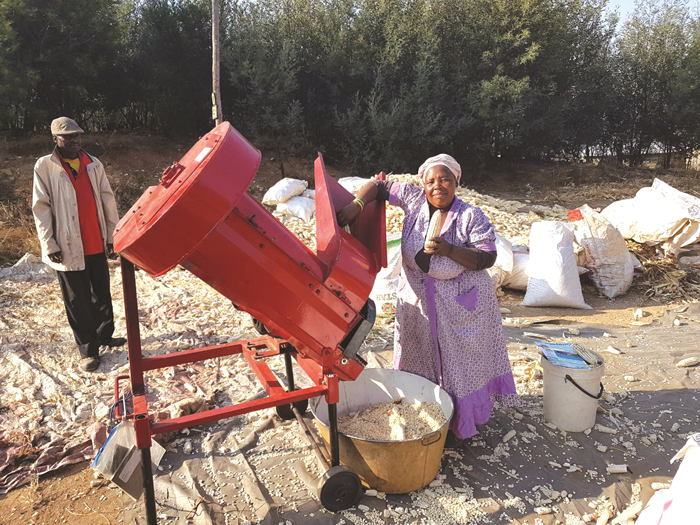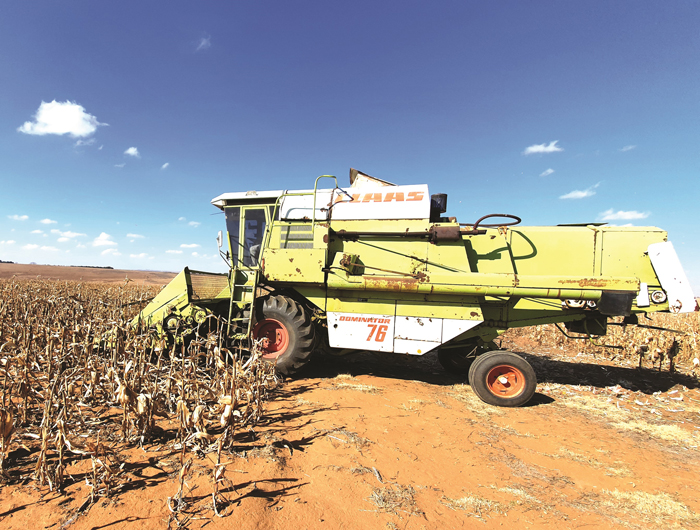May 2023
| JENNY MATHEWS, MANAGEMENT AND DEVELOPMENT SPECIALIST AND EDUCATOR |
 |
There is a proverb which states: ‘well begun is half done.’ in the case of grain farmers, this couldn’t be truer. It is not enough to grow a good crop if one does not have a plan for the final stages of production, when the crops need to be harvested and safely stored or sold.
Harvest time is the climax of a farmer’s agricultural calendar. It is the season when he reaps the fruits of his labour and gathers the return on his investment of money, time and energy. It is often also a time of intense pressure and stress, as farmers use the narrow window of opportunity between perfect crop maturity, the changing season and erratic weather patterns.
Common problems that lower your prices at the silo door are:

Harvesting using a mechanical threshing machine.
IMPROVING GRAIN QUALITY
Key factors to look at are crop maturity and general maintenance of the combine.
Crop maturity
It is important to know the maturing stages of the crop you are growing and to be certain of the moisture percentages that are suitable for harvesting and acceptable at the silos.
Sunflower: Physiological maturity in the sunflower plant is evident when the back of the plant’s head has turned from green to yellow and the bracts are turning brown. This occurs about 30 to 45 days after flowering and when the seed moisture is about 35%. The total growing period from seeding to harvesting is 125 to 130 days on average. A common mistake is to wait too long to harvest, as the seeds then become too dry and even fall onto the ground, which results in unnecessary losses. Harvesting can begin once 80% of the sunflower heads have turned brown. Local co-ops will only accept the seed deliveries when the moisture is 10% or less.
The period between maturity and harvesting should be kept as short as possible to ensure that losses due to bird damage, lodging (falling over), head-rot diseases and shattering are kept to a minimum.
Maize: Maize can either be harvested by hand or, more commonly nowadays, with a combine harvester machine. In South Africa it is common practice to leave the maize standing in the fields until it is well dried. This is the most economical method for the farmer. Moisture levels of 12,5% to 14% are ideal. A small sample can be tested for farmers at the nearest silo. It is important not to leave the grain standing in the lands for too long, as it will lead to losses.
Dry beans: Dry beans are so named because they are normally left on the plant until the pods have dried. The entire plant is then pulled up, placed in the shade where possible and allowed to dry for an additional one to two weeks. The dried pods are then split up and the beans removed.
Advisers warn that to avoid severe harvest losses, farmers should begin uprooting the beans from the field when only about 75% of the bean plants are dry. If the beans get too dry in the field, their pods tend to open on their own – causing the beans to fall on the ground and get lost for the farmer.
Experts recommend that the uprooting of dry bean plants should be done early in the morning and late in the afternoon, when the weather is not extremely hot, to avoid the cracking of pods. Dry bean plants that are delivered to farmers’ homes from the field, must be placed on clean tarpaulins, and kept dry and shaded to prevent the pods from cracking and spilling more beans.

During a farm visit, Jurie Mentz, regional development manager at the Louwsburg office, made this farmer stop the harvesting process to check the beaters, as too much grain was filtering through.
Machine maintenance
Because time is essential, it is important that farmers prepare properly for the harvest season to ensure that they can spend every available day harvesting and not wasting time fixing combine harvesters. Every lost day carries a price because the grain is losing weight and you will weigh in lower yields at the silo. You must ensure that all the seed is collected and ends up in the trailers headed for the market. Check the trailers for leaks and make sure the tyres are in a good condition.
THE HEADER
Note: The air speed for harvesting sunflowers is lower than for other grains due to the lightness of sunflower seeds. If the wind generated is too strong, it will blow even perfectly formed seeds right over the chaffer and sieve. The fan should be set so the airflow is enough to keep the trash ‘floating’ across the sieves or screens. Always check behind the combine and make sure that there are only empty seeds lying on the ground.
Another important consideration is the forward speed of the harvester, which should average 5 km to 8 km per hour. It should be decreased as the moisture content of the seed decreases or increased when the moisture levels are higher. This is done to reduce the shatter loss, as the sunflower heads feed into the combine. The drum speed should not be too fast, as it may cause too many seeds to break.
DAILY ROUTINES
It is very important to conduct daily maintenance checks, which include cleaning to keep the combine free of chaff and dust and conducting regular servicing. A compressor is useful to blow all the debris out of the combine’s working parts.
Other routines best performed when the engine is cooled or before starting up:
Attention to these details will result in optimal yields delivered.
TIPS TO CONSIDER
Too many farmers think that once the crop is mature it is not necessary to worry about weed control, but weeds influence the yields at harvest time and also the quality of the harvest. If weeds are in abundance, they slow the combine machine down, contaminate the grain and give it a bad smell, which will either result in a downgrade at the silo or additional costs to clean the grain and remove the seeds. Silo managers are particularly strict with seeds like the common ‘olie-boom’, which is poisonous for animals and humans. A team of ‘choppers’ through the field can drastically improve the quality of the grain delivered.
Publication: May 2023
Section: Pula/Imvula